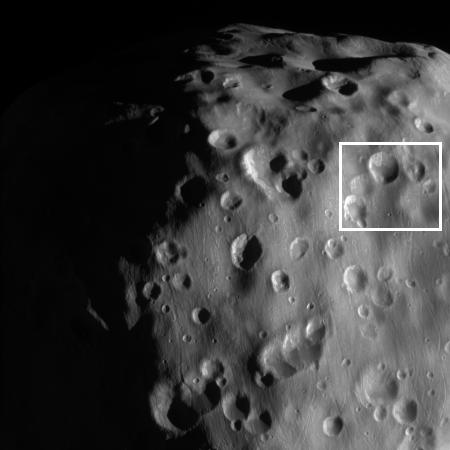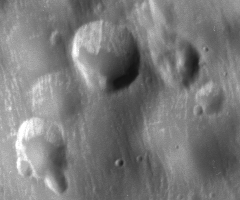The soft craters of Epimetheus

Cool image time! The image on the right, reduced in resolution to show here, is the highest resolution image that Cassini has taken of the Saturn moon Epimetheus, taken from only 9,300 miles away on February 21, 2017.
Epimetheus (70 miles or 113 kilometers across) is too small for its gravity to hold onto an atmosphere. It is also too small to be geologically active. There is therefore no way to erase the scars from meteor impacts, except for the generation of new impact craters on top of old ones.
Below is the inset at full resolution, showing several craters, with ponds of dust on their floor. Overall, the surface of this tiny moon looks soft. The craters are all shallow, as if any impact merely plunged into a blob of ice cream. Any ejecta from those impacts eventually rained back down, and then settled slowly in the moon’s low points, forming those ponds of dust.

In many ways this image is very revealing, as it shows what the early accretion process of any planetary body will look like. Nor is this unique. Earlier images taken of the asteroid Eros by the NEAR probe saw many of these same features, as have images of Saturn’s other small moons. In the early stages, new material gets absorbed easily because it finds it easy to bore into the body of the newly formed and not very dense planetary body. There isn’t much ejecta, and what there is doesn’t fly that far away so that it can settle back down on the surface and add to the new body’s total mass.

Cool image time! The image on the right, reduced in resolution to show here, is the highest resolution image that Cassini has taken of the Saturn moon Epimetheus, taken from only 9,300 miles away on February 21, 2017.
Epimetheus (70 miles or 113 kilometers across) is too small for its gravity to hold onto an atmosphere. It is also too small to be geologically active. There is therefore no way to erase the scars from meteor impacts, except for the generation of new impact craters on top of old ones.
Below is the inset at full resolution, showing several craters, with ponds of dust on their floor. Overall, the surface of this tiny moon looks soft. The craters are all shallow, as if any impact merely plunged into a blob of ice cream. Any ejecta from those impacts eventually rained back down, and then settled slowly in the moon’s low points, forming those ponds of dust.

In many ways this image is very revealing, as it shows what the early accretion process of any planetary body will look like. Nor is this unique. Earlier images taken of the asteroid Eros by the NEAR probe saw many of these same features, as have images of Saturn’s other small moons. In the early stages, new material gets absorbed easily because it finds it easy to bore into the body of the newly formed and not very dense planetary body. There isn’t much ejecta, and what there is doesn’t fly that far away so that it can settle back down on the surface and add to the new body’s total mass.
